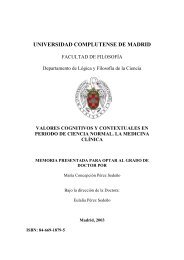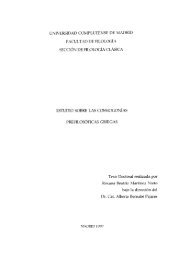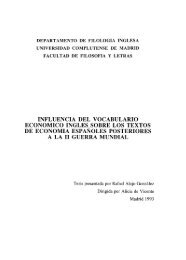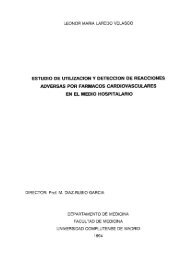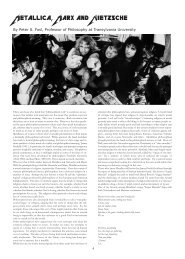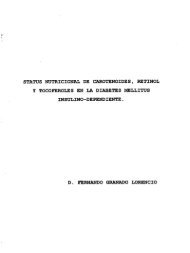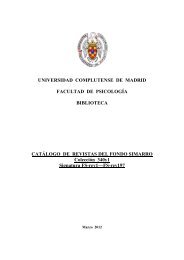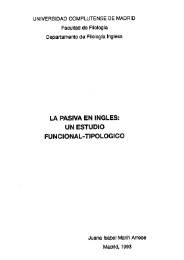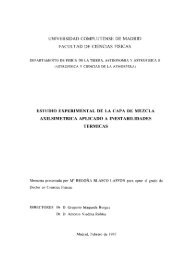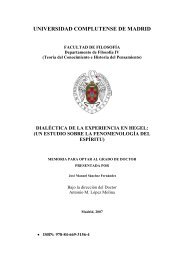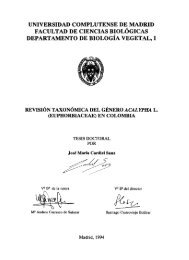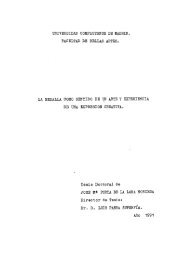- Page 1 and 2:
UNIVERSIDAD COMPLUTENSE DE MADRID F
- Page 4:
DISPOSICIÓN DEL PAÑO DE PUREZA EN
- Page 8:
AGRADECIMIENTOS A Ana Macarrón, mi
- Page 11 and 12:
ÍNDICE 4.3. Aragón...............
- Page 13 and 14:
ÍNDICE . Los comienzos: 1ª etapa
- Page 15 and 16:
OBJETIVOS GENERALES INTRODUCCIÓN E
- Page 17 and 18:
METODOLOGÍA INTRODUCCIÓN La metod
- Page 19 and 20:
TÉCNICAS Y MATERIALES INTRODUCCIÓ
- Page 21 and 22:
INTRODUCCIÓN Podemos establecer po
- Page 24 and 25:
LA CRUCIFIXIÓN ICONOGRAFÍA La ima
- Page 26 and 27:
ICONOGRAFÍA A finales del siglo IV
- Page 28 and 29:
ICONOGRAFÍA Después de la invenci
- Page 30 and 31:
ICONOGRAFÍA 2ª - Un segundo tipo
- Page 32 and 33:
ICONOGRAFÍA LA IMAGEN DE CRISTO CR
- Page 34 and 35:
ICONOGRAFÍA LOS NOMBRES DE CRISTO
- Page 36 and 37:
EL CRISTO DE BURGOS. ICONOGRAFÍA E
- Page 38 and 39:
Jeremías 1, 12, María exclama: IC
- Page 40 and 41:
ICONOGRAFÍA convirtió en causa de
- Page 42:
ICONOGRAFÍA La principal encargada
- Page 46 and 47:
INTRODUCCIÓN ROMÁNICO La España
- Page 48 and 49:
ROMÁNICO Al mismo tiempo, en las z
- Page 50 and 51:
ROMÁNICO La persona que trabajaba
- Page 52 and 53:
ROMÁNICO columnaria de María en e
- Page 54 and 55:
ROMÁNICO un valor por sí misma, n
- Page 56 and 57:
ROMÁNICO Alemania, Inglaterra, Fra
- Page 58 and 59:
CATALUÑA ROMÁNICO La situación g
- Page 60 and 61:
LA IMAGINERÍA EN CATALUÑA ROMÁNI
- Page 62 and 63:
ROMÁNICO EL CRISTO CRUCIFICADO EN
- Page 64 and 65:
ROMÁNICO El grupo formado por Las
- Page 66 and 67:
LAS MAJESTADES ROMÁNICO El grupo f
- Page 68 and 69:
ROMÁNICO Las Majestades son repres
- Page 70 and 71:
ROMÁNICO 8. Visten túnica larga c
- Page 72 and 73:
ROMÁNICO de la misma. Como es habi
- Page 74 and 75:
ROMÁNICO La Majestad de la Llaguna
- Page 76 and 77:
ROMÁNICO De esta dificultad deriva
- Page 78 and 79:
ROMÁNICO Las características fund
- Page 80 and 81:
ROMÁNICO cuerpo humano con una dis
- Page 82 and 83:
Las imágenes de Ix e Irevals parec
- Page 84 and 85:
ROMÁNICO posterior. Se sujeta con
- Page 86 and 87:
ROMÁNICO - la primera tiene una pi
- Page 88 and 89:
LOS CALVARIOS ROMÁNICO Con el nomb
- Page 90 and 91:
ROMÁNICO El fondo estilístico y l
- Page 92 and 93:
ROMÁNICO muchas otras representaci
- Page 94 and 95:
FIG. 8: Cristo del Museo Marés (n
- Page 96 and 97:
GALICIA ROMÁNICO El tardío comien
- Page 98 and 99:
ROMÁNICO Sin embargo, las circunst
- Page 100 and 101:
LA IMAGINERÍA EN GALICIA Es de sup
- Page 102 and 103:
ROMÁNICO En los primeros años del
- Page 104 and 105:
ROMÁNICO En este segundo tercio de
- Page 106 and 107:
LA IMAGINERÍA EN ARAGÓN ROMÁNICO
- Page 108 and 109:
ROMÁNICO podemos atribuir al siglo
- Page 110 and 111:
ROMÁNICO La restauración reciente
- Page 112 and 113:
presentes 13 ROMÁNICO numerosos ig
- Page 114 and 115:
ROMÁNICO El conjunto de circunstan
- Page 116 and 117:
ROMÁNICO El paño de pureza sigue
- Page 118 and 119:
ROMÁNICO Las relaciones con Navarr
- Page 120 and 121: SALAMANCA ROMÁNICO Esta región es
- Page 122 and 123: ROMÁNICO Las tallas de Cristo cruc
- Page 124 and 125: ROMÁNICO La gran variedad tipológ
- Page 126 and 127: 2. ROMÁNICO superior de este, que
- Page 128 and 129: 4. GALICIA ROMÁNICO La cuarta moda
- Page 130 and 131: ROMÁNICO Todos ellos tienen una fa
- Page 132 and 133: III GÓTICO 131
- Page 134 and 135: GÓTICO En la península ibérica,
- Page 136 and 137: GÓTICO Las luchas cotidianas, resu
- Page 138 and 139: GÓTICO La disposición regional de
- Page 140 and 141: GÓTICO También fue frecuente que
- Page 142 and 143: GÓTICO ordenado, un clérigo o alg
- Page 144 and 145: GÓTICO En cuanto al tipo de materi
- Page 146 and 147: divinidad, en el símbolo del triun
- Page 148 and 149: GÓTICO le apretaron fuertemente, l
- Page 150 and 151: GÓTICO El paño de pureza es largo
- Page 152 and 153: GÓTICO hacia la derecha y rostro a
- Page 154 and 155: GÓTICO A la misma tipología respo
- Page 156 and 157: ......GÓTICO Dentro de los tipos d
- Page 158 and 159: LA IMAGINERÍA EN CATALUÑA GÓTICO
- Page 160 and 161: GÓTICO Todas, o casi todas las im
- Page 162 and 163: De esta forma el estudio se realiza
- Page 164 and 165: GÓTICO De estas mismas caracterís
- Page 166 and 167: GÓTICO sobrantes de tela, que coin
- Page 168 and 169: GÓTICO aumento de la sensibilidad
- Page 172 and 173: GÓTICO largo, y se dispone en mech
- Page 174 and 175: GÓTICO Esta misma disposición del
- Page 176 and 177: GÓTICO Lo cierto es que, a diferen
- Page 178 and 179: FIG. 16: Cristo de Sanlúcar la May
- Page 180 and 181: CÓRDOBA GÓTICO Córdoba también
- Page 182 and 183: GÓTICO Roque de Sevilla, procedent
- Page 184 and 185: SEVILLA GÓTICO En Sevilla destaca
- Page 186 and 187: A finales del siglo XIII aparece el
- Page 188 and 189: Dibujo 10 GÓTICO Otra de las forma
- Page 190 and 191: GÓTICO La modalidad del Cristo gó
- Page 192 and 193: GENERAL Dibujo 15 191 GÓTICO
- Page 194 and 195: IV RENACIMIENTO 193
- Page 196 and 197: L OS ORÍGENES ITALIANOS INTRODUCCI
- Page 198 and 199: RENACIMIENTO De esta forma, en los
- Page 200 and 201: RENACIMIENTO que la de Juni es “f
- Page 202 and 203: RENACIMIENTO El dominio del reino d
- Page 204 and 205: RENACIMIENTO Los aprendices solían
- Page 206 and 207: RENACIMIENTO personaje más importa
- Page 208 and 209: RENACIMIENTO porque la obra que no
- Page 210 and 211: RENACIMIENTO Y para obviar en parte
- Page 212 and 213: EL CRISTO DESNUDO RENACIMIENTO El f
- Page 214 and 215: FIG. 18: Cristo crucificado de Migu
- Page 216 and 217: RENACIMIENTO LA ESCULTURA DEL RENAC
- Page 218 and 219: RENACIMIENTO El Segundo Tercio de S
- Page 220 and 221:
RENACIMIENTO La marcha de Siloé a
- Page 222 and 223:
RENACIMIENTO En 1528 viaja a Granad
- Page 224 and 225:
RENACIMIENTO de Campos, de las que
- Page 226 and 227:
RENACIMIENTO Felipe Bigarny, primer
- Page 228 and 229:
RENACIMIENTO Su arte se caracteriza
- Page 230 and 231:
RENACIMIENTO derecha, casi formando
- Page 232 and 233:
RENACIMIENTO Esta nueva manera escu
- Page 234 and 235:
LA ESCULTURA EN VALLADOLID RENACIMI
- Page 236 and 237:
El período anterior a España RENA
- Page 238 and 239:
RENACIMIENTO escasez, pero sí tall
- Page 240 and 241:
RENACIMIENTO El Cristo Crucificado
- Page 242 and 243:
RENACIMIENTO el rostro hacia arriba
- Page 244 and 245:
RENACIMIENTO A esta estructura más
- Page 246 and 247:
RENACIMIENTO JUAN DE JUNI busca la
- Page 248 and 249:
RENACIMIENTO Tanto obras vallisolet
- Page 250 and 251:
V BARROCO 249
- Page 252 and 253:
BARROCO El afán imperialista de la
- Page 254 and 255:
BARROCO Durante esta época las cri
- Page 256 and 257:
BARROCO A pesar de estos primeros r
- Page 258 and 259:
LA IMAGINERÍA EN ESPAÑA BARROCO L
- Page 260 and 261:
BARROCO Andalucía, con Sevilla com
- Page 262 and 263:
LA IMAGINERÍA EN CASTILLA BARROCO
- Page 264 and 265:
BARROCO En sus primeras obras docum
- Page 266 and 267:
BARROCO parte de un paso de la Flag
- Page 268 and 269:
BARROCO Apenas cubre la desnudez, d
- Page 270 and 271:
BARROCO Una espina atraviesa la cej
- Page 272 and 273:
BARROCO La escultura de 160 cm de a
- Page 274 and 275:
BARROCO El Calvario de Santa Cecili
- Page 276 and 277:
Técnicas BARROCO Las técnicas emp
- Page 278 and 279:
LOS COMIENZOS: 1ª ETAPA DEL SIGLO
- Page 280 and 281:
BARROCO a las milicias de las India
- Page 282 and 283:
BARROCO Su fama goza de gran presti
- Page 284 and 285:
Pacheco, comentando su iconografía
- Page 286 and 287:
BARROCO La labor de Montañés es e
- Page 288 and 289:
BARROCO muy similar al de Jesús de
- Page 290 and 291:
BARROCO La obra realizada por el ma
- Page 292 and 293:
BARROCO apodo se debe a una leyenda
- Page 294 and 295:
BARROCO No podemos olvidar menciona
- Page 296 and 297:
BARROCO se sujeta a la cintura medi
- Page 298 and 299:
BARROCO éste. La policromía ha su
- Page 300 and 301:
BARROCO Es en este momento cuando A
- Page 302 and 303:
LOS MORA BARROCO Importante familia
- Page 304 and 305:
BARROCO La escultura barroca en Esp
- Page 306 and 307:
Dibujo 20 BARROCO 2º PERÍODO: el
- Page 308 and 309:
LA ESCUELA SEVILLANA: JUAN MARTÍNE
- Page 310 and 311:
BARROCO La estructura de sus paños
- Page 312 and 313:
HERMANOS GARCÍA BARROCO Los Herman
- Page 314 and 315:
VI CONCLUSIONES 313
- Page 316 and 317:
CONCLUSIONES CONCLUSIONES Aunque al
- Page 318 and 319:
Dibujo 1 CONCLUSIONES En la 2ª mit
- Page 320 and 321:
CONCLUSIONES 5. El tercer modelo es
- Page 322 and 323:
CASTILLA Y LEÓN Dibujo 6 CONCLUSIO
- Page 324 and 325:
Dibujo 8 CONCLUSIÓNES Finalmente,
- Page 326 and 327:
GENERAL Dibujo 9 CONCLUSIÓNES Si b
- Page 328 and 329:
CONCLUSIÓNES Esta fórmula se repi
- Page 330 and 331:
Dibujo 14 GÓTICO TARDÍO CONCLUSI
- Page 332 and 333:
RENACIMIENTO CONCLUSIÓNES En la pr
- Page 334 and 335:
JUAN DE JUNI CONCLUSIÓNES Busca la
- Page 336 and 337:
CONCLUSIÓNES El Crucificado acusa
- Page 338 and 339:
CONCLUSIONES Indistintamente se dej
- Page 340 and 341:
Son CONCLUSIONES Dibujo 21 obras de
- Page 342 and 343:
CONCLUSIONES contratos. La eliminac
- Page 344 and 345:
CONCLUSIONES La estructura de sus p
- Page 346 and 347:
HERMANOS GARCÍA CONCLUSIONES Los H
- Page 348 and 349:
CONCLUSIONES A partir del siglo XIX
- Page 350 and 351:
349
- Page 352 and 353:
BIBLIOGRAFÍA BIBLIOGRAFÍA AINAUD,
- Page 354 and 355:
BIBLIOGRAFÍA DELGADO ROIG, Juan: L
- Page 356 and 357:
BIBLIOGRAFÍA MARTÍN IBARRARÁN, E
- Page 358 and 359:
BIBLIOGRAFÍA VVAA: Catálogo de ob
- Page 360 and 361:
ÍNDICE DE ILUSTRACIONES ÍNDICE DE
- Page 362:
ÍNDICE DE ILUSTRACIONES MAPAS 4 Y



